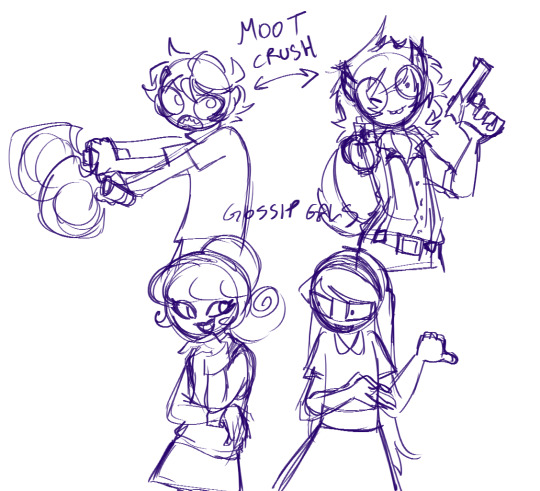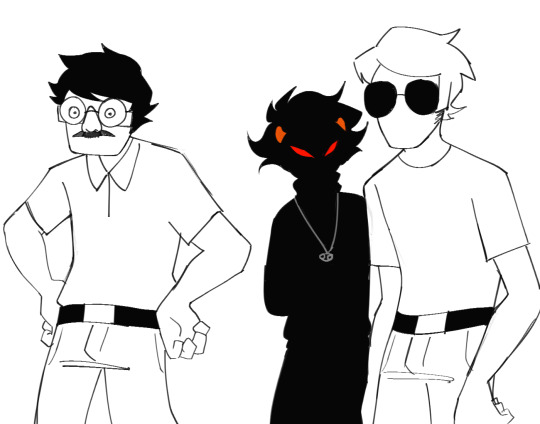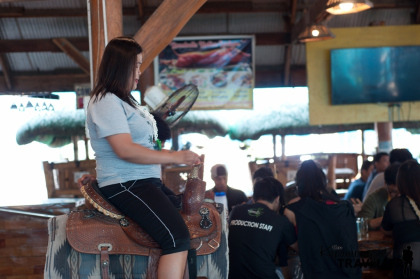#descend ascen-
Explore tagged Tumblr posts
Note
Could I perhaps ask you to talk about your fankids some more if you have the time? I love their designs, especially the davekat fankids. Your art is super cute too!
Of course and always! (^v^) Get ready, this is gonna get loooong……
First i want to talk aboat their relationships with their parents/guardians, ranked from best to worst:
Harper: He is a good buoy! Very cheery and active, he's loyal to his mother, but also won't pass up on an opportunity to misbehave, hehe. He always acompanies her on her expeditions and (almsot) always obeys, unless it involves getting dirty. He loves splashing mud, ink and whatever eeeeeeeverywhere….
Beatrice: She really admires her mothers and aspires to be like them, following most of their hobbies and overall always interacting. Bea isn't afraid to speak up her mind with them aboat what she is thinking or what she is doing, because as long as she doesn't die, she's allowed to do whatever she wants lolz
Danny: He has a good relationship with his parents, but he also wishes they weren't so damn overprotective and nosey in his life! Especially Dave, who's always teasing him about his more cheesy interests like romance and emo bands. Like Beatrice, he really admires his parents and wants to be like them, even if he acts really bratty and spoiled, he genuinely enjoys their company.
Judy: Dearest Judy….Her relationship with her dad is….complicated. At least that's how she sees it. Because her dad is a prankster, she is almost always annoyed by him and his near-constant house traps. Poor girl can't even step into the hallway without getting a bucket-full of water in her head! John is not aware of her extreme distaste for his interests, he thinks it's just teen rebellion or somefin, he's trying his best with her.
Also, some extra info!
if Bea were to die, she would be capable of becoming a rainbow drinker.
Danny, to differentiate between parents, refers to Karkat as "crabdad"!
Harper refers to his mom as also his owner and master
Judy actually does care for her father....their personality just don't match up at all!
Unfortunately, due to his naive nature, Danny ends up more often than not being the butt of the joke, especially by Beatrice...
Typing Quirks:
both judy and harper use lowercase, but! harper's is more animated and haz m ore typing mistakses!!!!!, while judy is more LIKELY TO USE UPPERCASE TO THINGS SHE MIGHT WANT TO EMPHASIZE OR IS NOT PLEASED WITH. >:B
~Beatrice puts a tilde at the beginning of every paragraph. Her sentences are definitely not filled with lots of sarcasm and easy reading. When annoyed her sentences have less punctuation and more urgency to get her point across
DANNY TYPES IN THE TRADITIONAL VANTAS UPPERCASE, BUT HE MAY shift to lowercase if he's trying to impress someone new by appearing nonchalant, or when he's talking to his dads VERY OCCASIONAL USE OF PUNCTUATION. <-!!!!
RANDOM DOOTS TIME!!!




#i might update this post once i think of more things to put ehhe#homestuck#ask#davekat#rosemary#davekat fankid#rosemary fankid#delta kids#john egbert#rose lalonde#descend ascen-#dave strider#jade harley#karkat vantas#kanaya maryam#judy egbert#harper harley#danny s-v#beatrice m-l#ruroekaki#sorry for tag spam but i hate unorganizationjjnjdfjkjn#long post
45 notes
·
View notes
Note
What does it mean to have Mercury and Saturn in opposition to my ascendant in the birth chart? and venus ascending trine? Neptune sextile ascendant? pluton ascending conjunction? Could you explain it to me? forgive me for my English so bad but I'm Spanish, kisses from Spain, I love your blog!
In the natal chart:
Mercury opposite Ascendant/conjunct Descendant - thoughts are heavily influenced by people around you, you are likely a very good listener, however there can be times where you lose your own ideas to those that are from your friends/partner/etc.
Saturn opposite Ascendant/conjunct Descendant - A very loyal friend, you take relationships very seriosuly however there can be certain consequences regarding that area of your life. You might attract more immature people due to the fact you’re seen as the reponsible one, you can attract controlling people or be the critical one. A lot is learnt through relationships.
Venus trine Ascendant - you give a good first impression, like to present yourself in a good way/try to look good.
Neptune sextile Ascendant -there can be a certain kind of dreamy-ness, you might often morph into the people around you(this is more likely to happen to someone with a conjunction)
Pluto conjunct Ascendant - there is an intensity, which can sometimes be scary to the people you’re around, those who don’t know you that well. People might feel that you see through their soul. Very aware of your surroundings.
#mercury opposite ascendant#mercury conjunct descendant#saturn opposite ascenant#saturn conjunct descendant#venus trine ascendant#neptune sextile ascendant#pluto conjunct ascendant
436 notes
·
View notes
Text
BY REQUEST #13 THE DESCENDANT
You ask, we (eventually) answer. Here’s the goods on everyone’s most forgotten degree. There’s a bunch of different ways you can think about this shit, we’ll look at it from a couple different angles.
First: Astrology runs on opposites and complements. All degree pairs have history. The Descendent is forever tied up with the Ascendent. They’re pointless without each other. So if you really want to understand your Descendent, you gotta bring your Ascenent into it. The Descendent is a reflection of your Ascendant. Here’s the real deal: the Descendent is how you appear to the world, not the Ascendent - that whole “the mask you wear” dick guzzling Ascendant BS? No. That’s actually Descendent territory. The Ascendent is an inside degree, the Descendent is an outside degree - it’s how you appear in action.
In other words: The Ascendnt is how you feel about yourself, the Descdent is what those feelings actually look like to everyone else. The Descendent is a visual degree. It’s objective. It’s the behavior and persona you put out there.
But I thought the Descendent was who I’m looking for in partner?? Ugh. No. Listen - that shit misses the point. The Descendent is really what you’re looking for in yourself, not in somebody else. At some point it’s not enough to feel yourself, you want to see yourself, you want to experience yourself. But, as a society, we’re trained to externalize our power and worth - so, fine, yes - our own shit usually ends up popping up in the people we surround ourselves with. But, it really doesn’t have shit to do with those fools, it has to do with us trying to find pieces of ourselves in the world so we can understand and accept ourselves (7th house!!!).
And so, the Descendent can also represent what inspires us. It’s a fucking thrill to get down with yourself, but most of us don’t really appreciate ourselves because we got fucked up at some point, so we’ll go for the next best thing: someone similar that we can project our positive qualities onto and love instead. And so, from another angle, this is what the Descendent really is: a projection. It’s a you that you can experience. Whether you access that through through a partner, though friends, through whatever and whoever the fuck you spend your time with, it doesn’t matter. It’s just important to remember that it’s really not about them, it’s about you.
The flip side? It’s just as easy to project your ugly-ass qualities all over everything as it is your positive ones. What, you thought you were getting out of this easy? Bitch, please. There’s hang-ups here that you gotta work out if you want to share with others on a real, deep level (8th and 9th houses!! It’s all connected!!). The Descendent is a preparatory degree. You’re testing yourself out. You’re seeing who you are in action. You’re either going to choose to become aware of yourself and how you appear so that you can work your shit out and actually start connecting with others, or you’re going to commit to being a hot ass denial soaked mess with a thriving toxic relationship orchard. Hard choice?
Alright, alright. Enough. Here’s the shit you’re really after. Without further ado, particulars for the party people:
DESCENDANT IN ARIES you gotta own the role you play in making yourself a miserable confused mess and stop with all this massively unaccountable bullshit you pull in all of your relationships - you’re inspired by people who are down to connect, and radiate humor, generosity, calm and confidence on the daily, why? Because that’s what your LIBRA AC should look like in action, fucker.
DESCENDANT IN TAURUS you gotta open your fucking eyes, stop pushing everyone away, and deal with your all your repressed feelings before they acid style eat your life for breakfast - you’re inspired by people who show strength, determination and commitment in their life and relationships on the daily, why? Because that’s what your SCORP AC should look like in action, fucker.
DESCENDANT IN GEMINI you gotta open your fucking mind, stop hyper focusing on random, irrelevant information, and keep your eyes on the big picture before you suffocate to death under a pile of unfinished puzzles - you’re inspired by people who are curious, introspective, and have a well developed, comprehensive life philosophy, why? Because that’s what your SAG AC should look like in action, fucker
DESCENDANT IN CANCER you gotta wipe the tears away from your eyes long enough to see that you chose to isolate yourself, and that no one is going to be able to get close to you if you refuse to get close to yourself - you’re inspired by people who have a wide variety of close, resourceful, emotionally nourishing connections, why? Because that’s what your CAP AC should look like in action, fucker.
DESCENDANT IN LEO you gotta chill the fuck out, calm the fuck down, and think about how you want to be perceived before you act, because the people are watching and they are not liking what they see - you’re inspired by people who are kinda different, organized, prepared, and making big moves with the quickness, why? Because that’s what your AQUARIUS AC should look like in action, fucker.
DESCENDENT IN VIRGO you gotta soften your rigid ass way of looking at things and stop being a manipulative, cold hearted stone of a bitch - you’re inspired by people who can blend compassion, wisdom, strength and love into one beautiful package of flaming hot realness, why? Because that’s what your PISCES AC should look like in action, fucker.
DESCENDENT IN LIBRA you gotta stop intentionally throwing yourself onto every sword that ever existed and deal with your inability to see people and situations for what they really are - you’re inspired by people who can take shit as it comes, meet people exactly where they’re at, and maintain their individuality bravely and beautifully at all costs, why? Because that’s what your ARIES AC should look like in action, fucker.
DESCENDENT IN SCORPIO you gotta stop fucking lying to yourself. Period. Stop it. There’s nothing else to say - you’re inspired by people who are trying to get to the bottom of their shit, clear all that old biz out, and actively move their lives forward in newer, deeper directions, why? Because that’s what your TAURUS AC should look like in action, fucker.
DESCENDANT IN SAG you gotta get your whack ass world view in check and stop trying to sew together the most fucked up, unaccountable narrative, it’s ugly and no one is buying it but you - you’re inspired by people who are genuinely open, knowledgeable, down to discuss anything and everything and be changed doing it, why? Because that’s what your GEMINI AC should look like in action, fucker.
DESCENDANT IN CAPRICORN you gotta stop pretending the way you’re living your life feels good when you’re clearly going through the motions like the fucking shell of a marionette - you’re inspired by people who are crazy grounded, have emotionally nourishing relationships, and truly know themselves inside and out, why? Because that’s what your CANCER AC should look like in action, fucker.
DESCENDANT IN AQUARIUS you gotta start directing all that energy you put towards finding the easy way out into developing your character before your midlife crisis hits - you’re inspired by people who radiate personality, positivity and confidence, and inspire love and dedication through being an all around good ass person, why? Because that’s what your LEO AC should look like in action, fucker.
DESCENDANT IN PISCES you gotta martyr your martyrdom before it’s too fucking late and stop trying to sell yourself on the interpretation of events that keeps you helpless and stalled out as fuck - you’re inspired by people who thoughtfully put their principles into practice and actively create the unique little lives they want, why? Because that’s what your VIRGO AC should look like in action, fucker. Peace, bitches. Happy charting.
XO BULLSHIT FREE ASTROLOGY
547 notes
·
View notes
Text
ascys
fantasy au genre high fantasy, royalty keywords royalty, island, healing, magic inspired by game of thrones
› summary
on a small island a few miles north-west of lys lies the city of ascys, the valley of tears.
› details
WELCOME TO THE CITY OF ASCYS the land of the unicorns, the valley of tears, the den of blood witches
the city of ascys is situated on a small island a few miles north-west of lys. it is primarily known for being the center of medicine and medical training in the modern world. though ascys does not hold a monopoly over medicine-production, their salves, potions and antidotes are definitely the rarest, most expensive and most effective in the world. so much so that being in possession of the trademark white-crystal bottle the medicines of ascys are stored in has become a symbol of wealth.
doctors, surgeons and maesters who have trained in ascys’ school for healing and medicine, a large compound in the heart of the city called ‘The Terminal Vale,’ are held to a higher standard than their contemporaries. graduates of the terminal vale are decorated with a white pin depicting a snake coiled around a unicorn horn. royals, noblemen and peasants alike from all across the world clamor for a place in this institution as acceptance is known to be very competitive and highly incorruptible.
ascys is also known to be the only place in the world to house unicorns; beautiful white stallions adorned with a single horn on their head and magical healing abilities. they are kept heavily guarded in a sanctuary on the island. just as the targaryens are believed to be descended from dragons, the royal family of ascys, named the ascys in honor of the island that their ancestors found, are believed to be descended from a family bestowed with gifts by the magical unicorn; being able to heal themselves abnormally fast, being immune to disease, and being strikingly beautiful.
the south of the island is dedicated to housing several resorts, hot springs, healing gardens and various similar vacation spots; all of which are businesses run by locals offering many services that cannot be found anywhere else in the world. a central theme around these attractions is the utilization of unicorn tears. though the citizens of ascys, called the ascen, are generally wary of strangers and travelers, and have strict laws dictating who can and cannot enter their city proper, all tourists are welcome to sail from all over the world to flock the curious places south of the island.
(less revered stories about the valley of tears say that it is also the den of blood witches. to scare their children, parents tell stories of blood witches hiding in the mountains of ascys, waiting for the full moon to lure children and men, then devour them. however, this is mere gossip, and no accounts of blood witches on ascys have been documented.)
it has become a curiosity for even their own people that the ascen live well but do not live long, with the average life expectancy of citizens being forty years old.
for fear of offending them and losing the privilege of their business, no one dares to touch ascys or her people, which is how the city has gained fame for being a ‘safe haven’ of sorts; so far removed from the turmoil of the rest of the world that it seems as if it’s a different world entirely .
HISTORY
like most of the free cities, ascys was founded on the ashes of old valyria. however, it is a relatively new state. barely two centuries ago, a wet nurse fleeing the land of lys with a baby she had stolen stumbled upon an island thick to the brim with trees and forest. desperate for shelter with nowhere else to go, she braved the daunting woods, and to her surprise, found no signs of wildlife among the kind flora. with the child on her back, she climbed rock mountains and waded through tall grass in search of answers, and, finally, she stumbled upon a clearing beside a river.
there, in the heart of the island, the woman from lys found the most beautiful white stallions she had ever seen. they were peculiar, too; their heads adorned with one elegant, glittering horn. soon, she discovered that the water from their mouths could close old wounds, and their tears could heal the most viral of illnesses. although wildlife was nowhere to be found, the woman and her baby never starved for the beautiful horned creatures sustained them.
years later, when the baby became a boy, made strong and handsome by the love of the horned creatures that helped raise him, his mother fell gravely ill with a sickness that none of the creatures could heal. so, he left the island with promises of a medicine, and came back with a ship-full of willing witches and doctors; some eager to help, others excited by the prospect of a new life and a clean slate.
though all efforts were exhausted, the boy’s mother passed away. and in her honor, he lead the efforts of the people to build what the world now knows as the city of ascys. he became known as dongbi, the first healer, and served as the ascen’s leader until his death, at which point his eldest offspring, a daughter named hanying, took his place.
the monarchy birthed an aristocracy, the nobility made largely of the families of people from the first ship. however, the first family’s rule has continued uncontested until the present. lead now by the queen, the city of ascys continues to prosper.
HOUSE ASCYS
THE ROYAL FAMILY THE HEAD OF A UNICORN "MIND, BODY, HEART AND SOUL"

the ascys have been the ruling family of ascys since the land was discovered. their ancestors are believed to be blessed by unicorns. similarly, their predecessors are believed to have inherited that same magic in their blood, with some members of the family having abilities such as regenerative healing, immunity to disease and god-like beauty. most of the ascen have a reputation for being snobby and close-minded to foreigners and the unfamiliar; most members of this house exemplify these traits. house ascys' sub-plot the queen (f, 25-27) rules the city today. for a long while, many thought her to be the sole heir to the throne after her elder brother, the prince (m, 28-30), mysteriously disappeared when he was only ten years old (many believe he was stolen by blood witches and hidden in the Mountains of Ravine; also called the blood mountain.) although the prince has returned and has been back for nearly a year, he is much changed; locked in his room for days at a time with his nose buried in books, some even say he's practicing blood magic that he learned from the witches who stole him. many consider him unfit to rule. afraid to face the possibility of an empty throne, the queen is being pressured by the court to birth many heirs. though it is the ascen's tradition to have only one ruler, with heirs being birthed through the union of the ruling monarch and their chosen member of the kai, it is considered the ruler’s prerogative to indulge their chosen affairs. and so, for years, the sun (from nobility) and the soldier (the queen’s chosen member of the kai) have battled for her affections. the queen is constantly seen visiting the terminal vale where her closest friend, the healer, studies the medicinal arts.
HOUSE EOS
NOBILITY — ALCHEMISTS AND HEALERS A GOLDEN TREE "ASHES TO ASHES"

descended from a talented wood witch that came from the first ship, those belonging to the house of eos find themselves inexplicably drawn to nature. they are a large family consisting of some of the island's most talented alchemists, and they are credited for keeping the practice of herbalism alive in ascys. they gained power and influence after leading the efforts to make unicorn tears ascys' primary export product. they are tasked with guarding the unicorns' sanctuary, and many of them teach at the city's famed school. there are rumors that some members of this family have been gifted (or cursed) with immortality. house eos' sub-plot it's one of the island's greatest secrets that the caretaker (m/f, any age) is the true face of the songs and legends; an alchemist gifted with immortality. it is said that they have been present since the arrival of the second ships. at first, healers thought them to be afflicted with an incurable disease, but now, they remain youthful when they should have long since turned to ash. no one knows that the caretaker is real except for the healer (m/f, 18-25), who is thei grandchild, closest confidant, as well as the queen's closest friend.
HOUSE AURIS
NOBILITY — MERCHANTS AND SAILORS A RED SUN BEHIND A BLUE WAVE "LET THE SUN MEET THE SEA"

descended from the captain of the first ship, an experienced pirate, house auris is said to be the wealthiest family in ascys. they are tasked with the import and export of products, and are known for their silver tongues. they say an auris can sell you the very air you breathe. they are charismatic and courageous. house auris' sub-plot house auris' legacy is carried by the shoulders of the eldest twins: the sun and the sky (m, 21-27). they are famed for their adventures, stories and good looks. in addition, the youngest of the auris siblings, the star (m/f, 18-25), has reached early fame for being one of the most beautiful citizens and one of the most talented artists that the island has ever seen. because of their talent and good looks, the three auris siblings have been called the holy trinity or the three god-sends, and many have said that the auris' golden age has arrived.
THE KAI
THE KNIGHTS

the tradition of knighthood was brought to ascys by the third king who learned of this tradition from his encounters with the westerosi. ascys' order of knights is called the kai, and knights are called kai. the men and women of the kai are traditionally offered up by families from the lower class when they are seven years old. from there, they are trained rigorously to become human shields and weapons. they are kept away from their families for the duration of their training, then when they turn eighteen, they are either sworn into the order, gifted to noble families, or returned to their own families—depending on the level of skill they've achieved. being accepted to be trained by the kai is an honor and a sign of good family blood, as the order only takes in young boys and girls who are of good health. the kai are tasked with guarding the royal family, the citizens and the unicorns; and with providing heirs to the throne. they are married to the order, forbidden from fornication with anyone but the members of the royal family that call for them, and are sworn to surrender their children to the royal family.
THE HEALERS OF ASCYS
FROM THE TERMINAL VALE

trained in the terminal vale, the world's most well-known and well-respected institution for medical arts, the healers of ascys are tasked with serving both the city of ascys and the rest of the world. they are among the most well-respected citizens of the city, decorated with a white crystal pin depicting a snake coiled around a unicorn horn. though it is difficult to get into the terminal vale for citizens and foreigners both rich and poor, becoming a healer trained in the city of ascys carries a weight that assures income and respect anywhere in the world.
3 notes
·
View notes
Note
2/ a relationship with his mother, which ended after Rainier interview. Albert never denied Alexander was his son. Both cases came into light arounds Rainier's death. In Monaco the line of sussecion was different once someone ascened to the throne only his descendants were heir. So basically if Albert didn't have legal kids Monaco would and being part of France. Rainier change the law and his daughters are now in the line. We know Charlene and Albert are a couple at least since 2006 .
.
0 notes
Text
Looking for a one-day road trip and activity? Go for Tanay, Rizal. Being near from NCR, this high altitude town offers breathtaking destinations and activities that would surely feed your adventurous souls. Winding mountain roads and pine trees are my favorite sceneries as we traverse the roads leading to different destinations. My heartfelt thanks to Sir Jeff Pino of Tanay Tourism Office for organizing this familiarization tour. Despite the Southwest Monsoon, we are blessed to have a fine weather on the day itself.
How to commute to Tanay?
There are jeepneys and FX from Cubao and Starmall going to Tanay. From there, you can charter a tricycle to bring you to your destination of choice.
What to explore in Tanay in a day?

San Ildefonso de Toledo Parish Church – one of the oldest churches in the Philippines and its beautiful facade is picture-perfect. It also has one of the intricate retablo I have seen in my travel history.

Beautiful retablo
Declared last 2001 as a National Cultural Treasure Church by the National Commission for Culture and the Arts, it is one of the sites to see in Tanay. Other pilgrimage sites to see in Tanay is the Regina Rica, one of the crowd drawer site in Tanay.

Daranak Falls – this iconic waterfalls of Tanay is one of the picture-perfect destinations of the town. It is a developed nature park that can cater from youngsters to our senior tourists who want to experience Mother Nature’s beauty. From developed road networks, erected huts, available stores, and multilevel function halls, this spot would engage your entire barkada or family. The main cascade of the waterfalls is a sheer drop of 14 meters to a deep icy cold catchbasin for bathing. If not swimmer, best to don lifevest. There are footbridges that connect both sides of the park.

Food stall inside the park
How to go to Daranak Falls?
From Cubao: take Cogeo bound jeep or van. Take another Sampaloc bound jeep. Once on Sampaloc Market, charter PATODA tricycle to Daranak Falls. Php200 with maximum of 4 passengers.
From Starmall: Take jeepney or FX to Tanay. Once in Tanay market, charter PATODA tricycle to Daranak Falls.

Calinawan Cave – a historic cave with a developed surrounding ready for the influx of visitors. Prior to actual spelunking, visitors must register on the adjacent hall and attend a short briefing about rules and regulations for safety. Also, pay the registration fee and choose a snug-fitting helmet.
Its main cave entrance is situated a few steps from the road and features a descending footpath. The cave system has seven explorable levels. However, during rainy season, the lowest 3 levels could be inundated and unsafe for spelunking. We were given the opportunity to experience the first two levels.

Can you see the human face?
The first level has some illumination from a naturally occurring orifice. There are natural rock formations depicting a human face and a knelt person.

Ms. Katherine Cortes of Taraletsanywhere blog
At the second level, the trail leads to a low ceiling chamber requiring explorers to kneel or duck walk to another end. There is also a phallic rock formation at this level. The exit trail features an ascending rocky and slippery trail leading to a high ceiling exit. This where explorers usually take a good photo thanks to beautiful natural diffused natural lighting. From the cave exit, it takes less than 5 minute walk back to the registration area.
The historical significance of the Calinawan Cave dates back from during World War 2, when the Japanese forces used the cave as a camp for two months before their actual surrender. The cave was discovered last 1572 without an identifiable person in record. However, the year 1901 when Mr. Felipe Matalino rediscovered the cave system. It is said that the seven-level or layer ends up in Wawa Dam in Montalban. However, this exit is bombed, apparently for protection. The etymology of “Calinawan” was derived from “an agreement of Filipino and American forces made clear to fight the Spaniards”.

Nagpatong Rock – located in Barangay Cuyambay, Nagpatong Rock is actually a side trip to Mt. Masungki. It features two towers of colossal rocks seemingly and perfectly stacked on top of each other, thanks to its naturally occurring horizontal dents lining the main rock tower. From the jump-off point, the average trekking time is about two to three hours, depending on personal pace. The trail starts with a dirt road under a canopy of trees. From there, you will pass by rice plantations and through a thick forest. There are portions of the trail that are concreted. The ascending part of the trail features an established rocky footpath with steep inclines.
Where to Eat in Tanay?

Rambulls Fastfood and Restaurant – a “bakahan” restaurant that is conveniently located beside the main road. I have eaten already here before and loved its bulalo! Another feature of this restaurant is a saddle placed in the middle of dining where you can take a photograph.
Main Dishes
Sweet choices

For inquiries, please contact the restaurant through mobile number +63 920 214 6434

Pico de Pino Restaurant – this is where we have light snacks after our Nagpatong rock adventure. It is conveniently located along Marikina-Infanta highway and has local products for pasalubong. Their menu ranges from breakfast meals, main meat dishes to snacks. Price ranges from a hundred til Php500.00.
Fresh Lumpia
Tasty Pancit!
For inquiries and reservation, you can contact Pico de Pino Cafe and Restaurant through mobile number +63 921 930 6033
Souvenir Items
Sauce in bottles
Sweets
My heartfelt thanks to Sir Jeff Pino, Tourism Officer for organizing this familiarization tour.

Thank you Sir Jeff!
More photographs during the familiarization tour.

Group shot inside Calinawan Cave

Post spelunking mode

Cuyambay Barangay Hall

Group Lunch before ascening Nagpatong Rock

Take that pose in Rambulls

Before going to Daranak Falls

The spacious area in Calinawan Cave

One of the rock formations in Calinawan Cave
TANAY: Must do activities in a day Looking for a one-day road trip and activity? Go for Tanay, Rizal. Being near from NCR, this high altitude town offers breathtaking destinations and activities that would surely feed your adventurous souls.
0 notes
Text
Sounding Together #31: L. van Beethoven, Symphony #3, “Eroica,” (1804)
So. We have finally arrived. This is the symphony that is touted as forever changing what the symphony was, for bridging the gap between classicism and romanticism in music, and for cementing Beethoven as a composer of great music, a new breed of musician, quite unlike Mozart or Haydn. This symphony has been examined and analyzed so many times, adding my own voice to the mix seems almost a futile gesture. And yet, I said I would look at the symphony over time . . . and I can’t very well do that and not look at the Eroica.
I was taught--as were many, I think--that this symphony was the beginning of the Romantic era of music. And while I think that’s a severe oversimplification, there’s no doubt that the symphony wouldn’t be the same after the Eroica. It should be noted, of course, that many of the so-called “revolutionary” elements of the symphony--the length, the strange harmonies, the early horn entrance--had been done before. Some of them we’ve already talked about. However, what Beethoven essentially does is take all of these odd elements from other symphonies, the little moments that stand out and briefly strike you as strange before the symphony continues on its merry way, and builds an entire work out of them.
One of the more famous stories associated with this symphony is the fact that Beethoven had originally intended to dedicate it to Napoleon Bonaparte, who Beethoven greatly admired, but upon hearing the Bonaparte had crowned himself Emperor, he was so enraged that he either tore the title page in two or scratched the dedication out so vigorously that he tore through the paper. (There are a couple different accounts of the incident.) Apocryphal or not, the story reveals Beethoven’s real passion. Napoleon was a figure of the French Revolution, wherein the monarchy was overthrown and, for a time, the people governed. (Relatively unsuccessfully, but never mind.) Beethoven was very much a champion of the human spirit and leadership by the people, and had little patience for titles or royalty, and in that sense, he was very much a romantic. And this symphony, regardless of its original intent, is very much a work of the people, intended not so much as an exercise in form and structure--though those elements are still present--but an exercise in expression and visceral emotion.
In spite of that, this symphony was not so easy to understand. Symphonies up to that point had a very predictable pattern to them, and analysis and interpretation were simply a matter of stating which theme started where and in what key. But this symphony was different, and audiences found it more than a little off-putting when they first heard it. (The second symphony got a similar, though far milder, reaction.) It wasn’t until the score was published and people could actually take time to study and analyze the symphony that it began to garner higher praise. Because there was more to this symphony than mere form and harmony. Music was passing from the Era of Stimulation to the Era of Expression, something which invited audience to ask the question: What is he trying to say? Because with this symphony, Beethoven was absolutely making a statement.
One of the elements of Romantic symphonies that became more prevalent was programmatic writing; that is music that represented some extra-musical element, an emotion or a story. Though we have seen some programmatic elements in some other symphonies, particularly Haydn’s, often these are assigned after the fact, and may or may not have been intentional by the composer. Though this work is not as programmatic in nature as later symphonies of the Romantic era, we can definitely see a more programmatic style of writing here. The name “Eroica,” or Heroic, was assigned by Beethoven himself, indicating a certain thoughtfulness in what this symphony was meant to represent. I’ve compared the structure of a sonata to the structure of a three-act story, and in the first movement of this symphony, we see another story: specifically, the Hero’s Journey.
In this symphony, Beethoven dispenses with the slow introduction and starts things off right away with two strong, loud chords in E-flat major. This gives way to the opening theme, which outlines an E-flat arpeggio, leaving utterly no doubt as to what the key is . . . before plunging down into the highly unusual C-sharp. So just seven measures in, Beethoven is already indicating to us that this is not going to be a typical symphony. Not only does C-sharp not belong in the key of E-flat, but with the high strings playing a tritone above, it creates an uncomfortable dissonance that takes a couple measures to resolve. Then the opening theme repeats in the winds, this time resolving in a far different manner, taking us to the third playing of the opening theme with the full orchestra and changing the key to the dominant B-flat. The transition to the second theme, then, occurs after the key has already changed, and contains in it three distinct motifs: a gentle lilting of descending notes, a pattering upward scale pattern, and a flurry of more descending notes, this time rougher and stormier. This transition gives us the fundamental conflict within this movement, which has a give and take between stormy and dramatic dissonance and a tone so gentle and spare, it almost sounds like it belongs in the second slow movement rather than the first. Perhaps that’s why Beethoven decided against a slow introduction: there’s already plenty of it within the movement proper.
The second theme is carried, as it often is, by the winds, and has an almost hymn-like quality to it. The forward movement almost stops here, and we’re given a brief moment to catch our breath before a few quiet, but gradually accelerating chords take us back into the excited flurry of the movement. As we move into the codetta, Beethoven plays with our expectations of the meter. This is a triple meter movement, but Beethoven puts orchestral hits on the off beats, finally using hemiola and putting a strong chord every two beats instead of three. As the movement ends with more dynamic and style contrast, we’re carried back to the key of E-flat and quieter opening, with one strong dominant chord finally pushing us the rest of the way into the repeat. Just in the exposition, Beethoven has already laid out much of what we can expect in the rest of this movement, as well as the symphony in general.
Strange though it may have sounded, the exposition was still easy enough to follow. Beethoven didn’t want to completely alienate his audiences, after all. He needed to make sure that no matter what experiments he performed on the symphony, it was still rooted in classical style and form, and those elements are still recognizable, if a little harder to pin down. It’s the development, though, which distinguishes this movement, as it is longer and far more intricate than any we’ve so far seen. Though Mozart’s Prague symphony may have had a longer first movement (if you observe all the repeats), with Beethoven, it’s the development section that lends most of the length, and it takes us on a ride through not only different keys and themes, but also vastly different styles. It begins very gently, and almost sounds as though it’s setting up an entirely different tempo, like the transition from the fast section of an overture to the slow section. The beat is very difficult to locate, even though the tempo has not actually changed. This eventually solidifies into the descending lyrical theme, still gentle, but with a feeling of the original tempo now. A little tension, and then the stormy theme returns again, followed by some of the hemiola patterns, similar to what we heard in the bridge before the full playing of the first theme. These rise chromatically, increasing the tension, and with a loud, blaring, and very dissonant chord, things quiet down again, bringing us to a completely new theme in the winds.
This new theme is gentle, another hymn-like passage, but more melodic than the second theme of the exposition. Indeed, it’s the most melodic passage in the entire movement. This serves as the midpoint of the development. Where the first half of the development mostly developed the transition themes, the second half deals almost exclusively with the opening theme. And here we see the advantage of having thematic material be more texture-based than melody-based. All Beethoven has to do is give us an ascending arpeggio--which he does, many times in many guises--and it has the feel of the opening theme. This texture alternates with the new theme, and then all this activity finally quiets down, and we have the infamous “early” entrance of the horns on the recapitulation, which, it should be noted, is a musical joke that already been employed by Haydn. And yet many listeners thought a mistake had been made, and that those silly horns had come in too early. (Silly horns . . .) A couple of loud chords later (an angry reaction to the early entrance, perhaps?) and the recapitulation proper begins.
We begin, of course, with the opening theme, but this time instead of resolving up, and C-sharp resolves down, giving us an entirely new take on the theme for the bridging passage, almost as if we’re not quite finished developing this particular theme yet. Then the orchestra comes through, we hear our three transition themes and the second theme, all in the tonic key of E-flat, and the recapitulation continues as normal . . . that is until the coda, which takes us on what could be considered to be a second development section, not nearly as extensive as the first, but one like might have seen in the days of Haydn or Mozart. The first theme is developed primarily, which could simply be the practice of playing the opening theme at the end of the movement except that the new theme introduced in the development section is also played here. The arpeggios build and build, resolving in the ascending pattern we heard in the transition of the exposition . . . but this time, it leads not to a storm, but to the final triumphant chords of the movement, ending the way it began. The Hero’s Journey is evident throughout the movement. The trials of a turbulent transition, the stormy development, the new lessons learned in a new theme, an impulsive early entrance, the return to the recapitulation, but with a stark difference even in the opening theme, and a final triumph over adversity. And that’s just the first movement.
The second movement changes the mood from one of triumph to one of grief with a funeral march, which has elements of rondo and even sonata in it as well. It begins as a typical march, with an opening theme in C minor. The theme is played again, this time ending in the relative E-flat major for the beginning of the second theme, which returns to minor relatively quickly, and then a repeat of the opening theme. This section is then also repeated, although in both cases, they are not literal repeats. That is, Beethoven doesn’t just throw in repeat markers, but rewrites the themes so that he can change certain things, like the color and tone. This opening section gives way to what would be the trio of the march, a gentle section in C major (actually marked “Major” in the music) with triplets in the accompaniment. It’s in the third section that things begin to get strange. Normally with a march, there would be a de capo and a return to the beginning of the movement, playing everything over literally. But again, Beethoven rewrites the opening . . . and then the third section becomes something else entirely. The opening theme gives way to a fugal passage built on an inversion of the second theme. The first theme returns, but is then interrupted by what can only be referred to as a mini-development section, featuring fragments of the opening theme interrupted by stormy textures. featuring a back and forth between the triplet accompaniment from the trio and the duple accompaniment of the rest of the march. Finally, the opening material returns, and we get the restatement of the opening section, eventually winding down to a fragmented playing the opening motif, as though theme was finally having an emotional breakdown over the grief of the music.
The third movement scherzo is at least easier to follow as far as form is concerned, though it does play with expectations of beat and meter. It opens with the strings alternating between two notes very quietly--in triple meter, remember, so the beat is almost impossible to find until the main melody comes in, which is really just a little flourish on the oboe. The entire opening section is basically built on that flourish, eventually bringing it in a different key, and then with the full orchestra. The second theme, if it can be called that, is a set of descending notes, written completely off the beat, making it necessary to throw a rest into the mix making it sound as though the music has tripped over itself, somehow. Then some back and forth between strings and winds brings us to the end of the opening section. The trio is carried almost entirely by a horn trio, with the other winds coming in on the secondary theme and the strings providing accompaniment. And again, Beethoven elects not to do a de capo, but instead to rewrite the opening section again, but with two major differences. First, at the descending pattern with the “trip” in the middle, he writes it differently the second time, switching to cut time and having the notes descend evenly, making it seem as though that was way those notes were always meant to be played. And second, he adds a coda to the end, with the orchestra giving the movement a grand ending that third movements don’t typically get. In that way, he has given more weight to what is typically a lighthearted, easy movement.
The finale of the symphony is a theme and variations, but much like the march and scherzo before, Beethoven takes what would ordinarily be a very simple musical structure and makes it into something much more. The main theme used here is actually a theme he had used in a previous work about Prometheus--a character who stole fire from the gods for humanity’s use, drawing something a parallel to humanity’s fight against monarchy at that time. Beethoven actually begins, not with the main theme itself, but the theme’s bass line, variations of which can actually be spotted in the previous three movements, lending evidence to the idea that this movement was actually composed first. Eventually, after a couple variations, the main melody make its appearance, and is also varied in numerous ways and moods. We see a fugal section in the middle, as well as a substantial slowing of tempo for a hymn-like section. And in the end, the movement ends as it began, with a flurry of notes and chords in E-flat major.
It’s easy to see why this movement was so difficult for audiences to understand upon first listening. They were used to music that was easy to follow, able to anticipate basic form, harmonies, and meters. But in this symphony, Beethoven plays with expectations on all three. Though the familiar forms, harmonies, and meters are there, they’re hidden, obscured by the thing that had taken precedence over all else: expression, the thing that would become the backbone of the Romantic era. Though it’s too soon to call the start of the Romantic era proper--classical form and harmony are still quite prominent after all--it’s easy to see why people call the Eroica the start of musical Romanticism. This is a piece of emotion.
#ludwig van beethoven#symphonies#eroica#symphony no. 3#symphony in e-flat#classical music#Romantic Era
3 notes
·
View notes
Text
Jaume Figueras
Jaume Figueras y su tienda de Las Ramblas.
Por Fernando Garcés.
(En catalán). Dos noms serveixen per designar la torre construïda per Gaudí sobre les ruïnes de l’antic palau del rei Martí. El més conegut és el de Bellesguard, que fa referència al nom que aquest rei li va donar al seu palau i que, en l’actualitat, rep també el carrer on se situa l’edifici de Gaudí. El segon nom és “Casa Figueras”, i aquest nom fa referència a la família que li va encarregar el projecte a Gaudí.
Quan Gaudí va dissenyar un escut familiar per Eusebi Güell va escriure el següent lema: “Ahir pastor, avui senyor”. En el cas dels Figueras se’n podria triar un de similar que digués: “Ahir pagès, avui Burguès”. En efecte, la nissaga d’aquesta família comença als camps de la ciutat de Piera, a l’Anoia, i continua a la ciutat de Barcelona, on van convertir-se en industrials tant del sector de l’alimentació com del sector tèxtil, però sobretot del primer.
La primera dada reveladora d’aquest ascens es documenta el 1820. Aquell any, Jaume Figueras i Bonastre va fundar una empresa de pastes de sopa al carrer Sant Ramon que, vint anys més tard, la família va traslladar a la cantonada de la Rambla amb el carrer Petxina. El 1902, els seus descendents van remodelar aquesta botiga amb la col·laboració de destacats professionals de l’època, entre els quals es trobaven el pintor i escenògraf Antoni Ros i Güell i el ceramista Mario Maragliano. En l’actualitat, aquest local és la seu de la popular pastisseria Escribà. A la façana, però, encara podem llegir “Antigua Casa Figueras”. L’any 2016 es va descobrir que els Figueras tenien una altra botiga al carrer del Carme, que segurament va ser decorada pels mateixos artistes que van treballar a la fàbrica de les Rambles.
El membre més conegut d’aquesta família va ser Jaume Figueras i Burull (1827-1877).
Jaume Figueras i Antoni Gaudí eren amics i van somiar i projectar plegats la Torre Bellesguard. Per desgràcia, Figueras va morir abans que Gaudí comencés les obres i qui va materialitzar el projecte va ser Maria Sagués i Molins (1835-1907), la seva vídua. En aquella època, la finca ocupava gairebé 12 hectàrees. Maria la va comprar el 12 de juny de 1900 per 65.000 pessetes. Les obres començarien el següent any. A la mort de la vídua, el 1907, la finca passaria a les mans de Jaume Figueras i Sagués (1871-1942), un dels seus tres fills. El 1909 Gaudí va abandonar l’obra per diverses raons, deixant la casa inacabada i no serà fins a 1916 quan Domènec Sugrañes es farà càrrec dels últims retocs.
La connexió de la família Figueras amb Gaudí ens condueix fins al Cercle Artístic de Sant Lluc, una institució formada el 1896 i de la qual tant Gaudí com els fills de María Sagués en van ser membres. Jaume Figueras i Sagués fins i tot fou el seu tresorer. A més a més, Joan Rubió i Bellver (enllaç al seu article), un dels principals col·laboradors de Gaudí, va ser el president d’aquest Cercle en dues ocasions (1904-1906 i 1912-1914). Tots ells compartien un profund sentiment religiós i una visió similar de l’art i la política catalana.
L’any 1899, el Cercle va fomentar la fundació d’una altra institució molt estimada per Gaudí, la Lliga Espiritual de la Verge de Montserrat. No és estrany, doncs, que a Bellesguard hi hagi diferents al·lusions a la Mare de Déu i la muntanya de Montserrat. Als bancs situats a l’entrada principal de la torre hi trobem la imatge de Montserrat, i al ferro forjat de la mateixa porta hi podem llegir: “María puríssima sens pecat fou concebuda”.
Izquierda: Montaña de Montserrat en el mosaico de los bancos principales de la Torre Bellesguard. Derecha: Detalle de hierro forjado en la puerta principal de la Torre Bellesguard.
La entrada Jaume Figueras se publicó primero en Torre Bellesguard | Exclusive Gaudí.
0 notes
Text
Jaume Figueras
Jaume Figueras y su tienda de Las Ramblas.
Por Fernando Garcés.
(En catalán). Dos noms serveixen per designar la torre construïda per Gaudí sobre les ruïnes de l’antic palau del rei Martí. El més conegut és el de Bellesguard, que fa referència al nom que aquest rei li va donar al seu palau i que, en l’actualitat, rep també el carrer on se situa l’edifici de Gaudí. El segon nom és “Casa Figueras”, i aquest nom fa referència a la família que li va encarregar el projecte a Gaudí.
Quan Gaudí va dissenyar un escut familiar per Eusebi Güell va escriure el següent lema: “Ahir pastor, avui senyor”. En el cas dels Figueras se’n podria triar un de similar que digués: “Ahir pagès, avui Burguès”. En efecte, la nissaga d’aquesta família comença als camps de la ciutat de Piera, a l’Anoia, i continua a la ciutat de Barcelona, on van convertir-se en industrials tant del sector de l’alimentació com del sector tèxtil, però sobretot del primer.
La primera dada reveladora d’aquest ascens es documenta el 1820. Aquell any, Jaume Figueras i Bonastre va fundar una empresa de pastes de sopa al carrer Sant Ramon que, vint anys més tard, la família va traslladar a la cantonada de la Rambla amb el carrer Petxina. El 1902, els seus descendents van remodelar aquesta botiga amb la col·laboració de destacats professionals de l’època, entre els quals es trobaven el pintor i escenògraf Antoni Ros i Güell i el ceramista Mario Maragliano. En l’actualitat, aquest local és la seu de la popular pastisseria Escribà. A la façana, però, encara podem llegir “Antigua Casa Figueras”. L’any 2016 es va descobrir que els Figueras tenien una altra botiga al carrer del Carme, que segurament va ser decorada pels mateixos artistes que van treballar a la fàbrica de les Rambles.
El membre més conegut d’aquesta família va ser Jaume Figueras i Burull (1827-1877).
Jaume Figueras i Antoni Gaudí eren amics i van somiar i projectar plegats la Torre Bellesguard. Per desgràcia, Figueras va morir abans que Gaudí comencés les obres i qui va materialitzar el projecte va ser Maria Sagués i Molins (1835-1907), la seva vídua. En aquella època, la finca ocupava gairebé 12 hectàrees. Maria la va comprar el 12 de juny de 1900 per 65.000 pessetes. Les obres començarien el següent any. A la mort de la vídua, el 1907, la finca passaria a les mans de Jaume Figueras i Sagués (1871-1942), un dels seus tres fills. El 1909 Gaudí va abandonar l’obra per diverses raons, deixant la casa inacabada i no serà fins a 1916 quan Domènec Sugrañes es farà càrrec dels últims retocs.
La connexió de la família Figueras amb Gaudí ens condueix fins al Cercle Artístic de Sant Lluc, una institució formada el 1896 i de la qual tant Gaudí com els fills de María Sagués en van ser membres. Jaume Figueras i Sagués fins i tot fou el seu tresorer. A més a més, Joan Rubió i Bellver (enllaç al seu article), un dels principals col·laboradors de Gaudí, va ser el president d’aquest Cercle en dues ocasions (1904-1906 i 1912-1914). Tots ells compartien un profund sentiment religiós i una visió similar de l’art i la política catalana.
L’any 1899, el Cercle va fomentar la fundació d’una altra institució molt estimada per Gaudí, la Lliga Espiritual de la Verge de Montserrat. No és estrany, doncs, que a Bellesguard hi hagi diferents al·lusions a la Mare de Déu i la muntanya de Montserrat. Als bancs situats a l’entrada principal de la torre hi trobem la imatge de Montserrat, i al ferro forjat de la mateixa porta hi podem llegir: “María puríssima sens pecat fou concebuda”.
Izquierda: Montaña de Montserrat en el mosaico de los bancos principales de la Torre Bellesguard. Derecha: Detalle de hierro forjado en la puerta principal de la Torre Bellesguard.
La entrada Jaume Figueras se publicó primero en Torre Bellesguard | Exclusive Gaudí.
0 notes